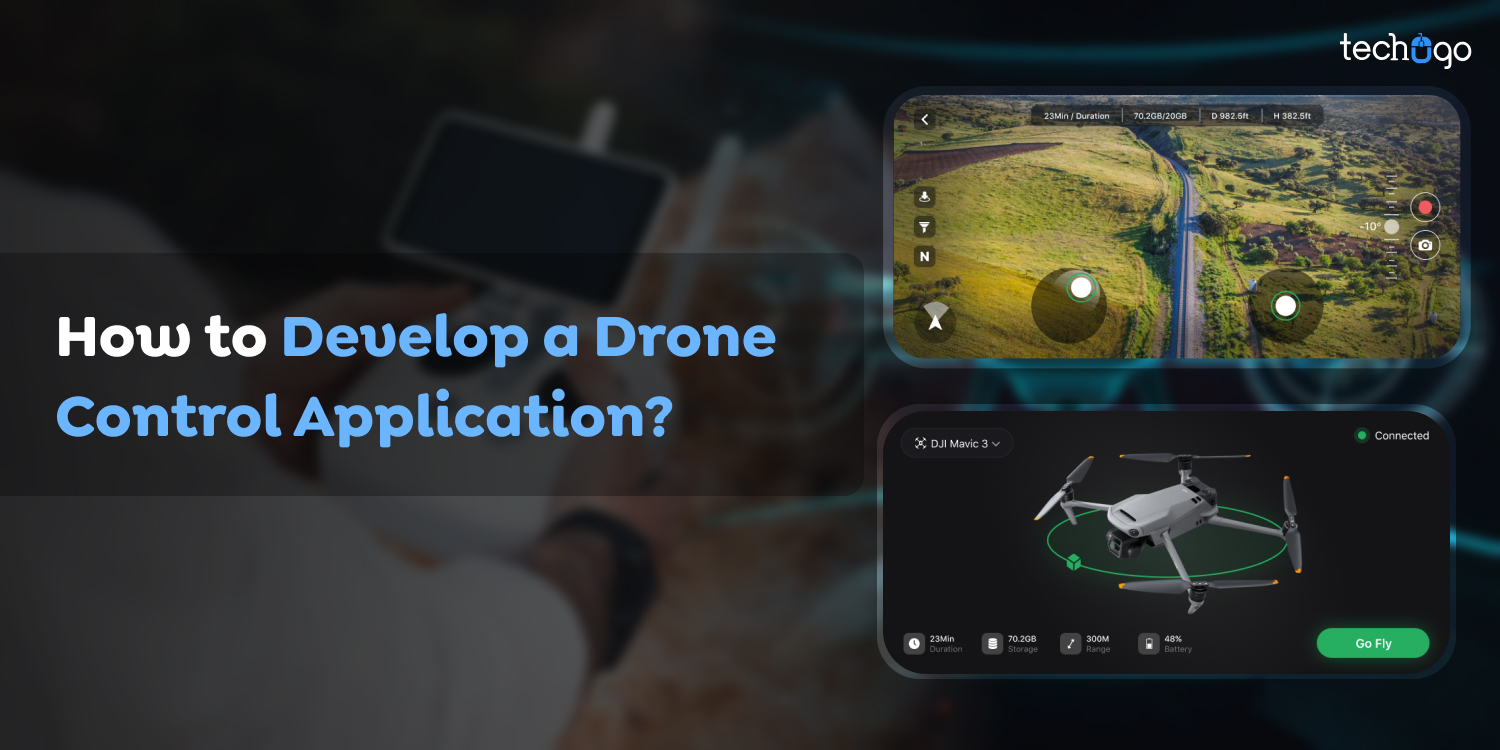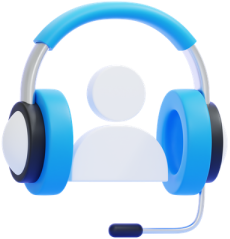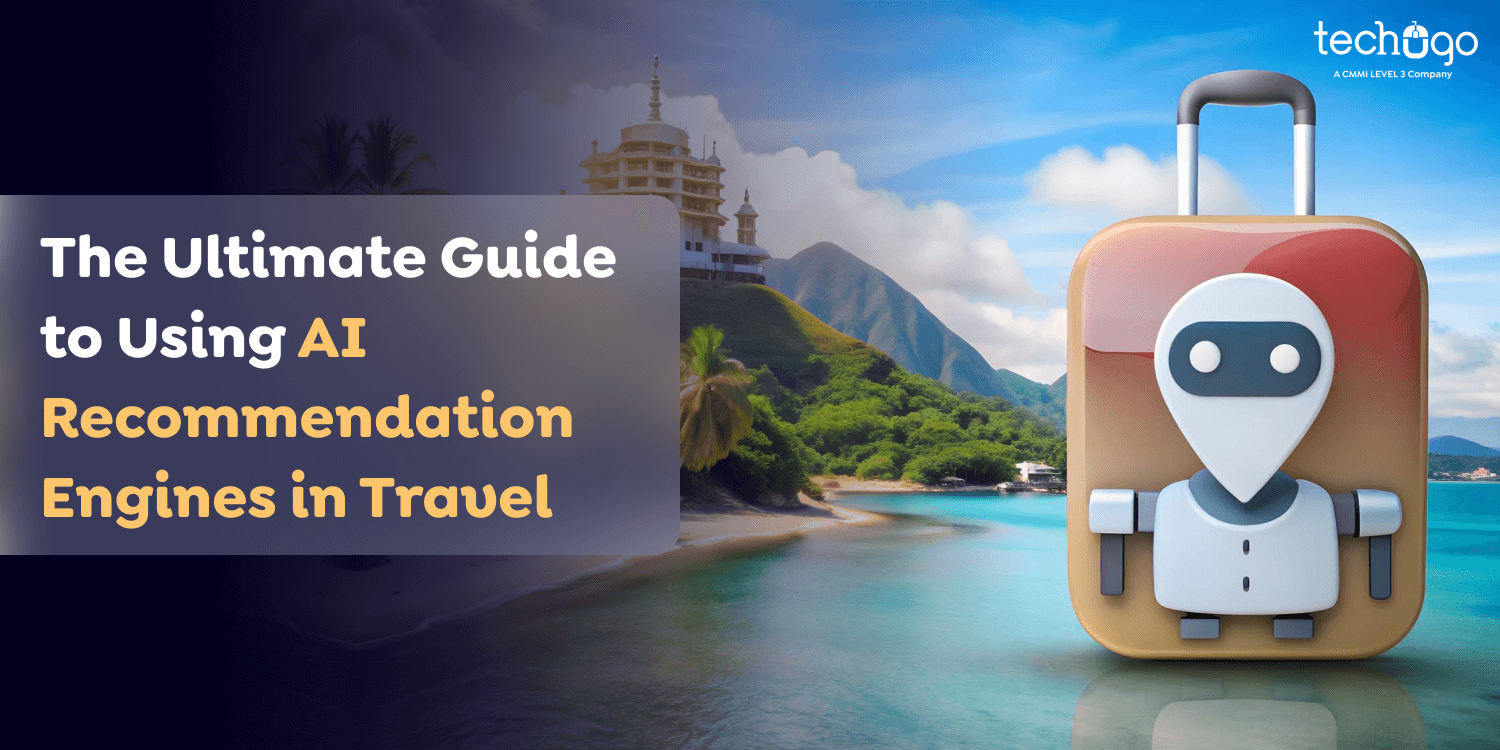21 Feb 2025
How to Develop a Drone Control Application?
Matthew Connor

Drones have become a crucial tool in fields such as agriculture, logistics, photography, and even surveillance. Their ability to collect important information, increase efficiency, and access difficult-to-reach areas makes them extremely valuable. With time, as drone technology continues to advance, the demand for reliable drone app development has also increased.
Modern drone control apps have evolved from basic remote controls to fully-featured applications that provide pilots with precise control and a comprehensive understanding of their drones. Hobbyists as well as commercial pilots now have access to features like automated flight modes and real-time information displays, making flying safer and more effective.
For businesses that rely on drones for critical tasks, having an efficient and user-friendly application is essential. Effective drone application development streamlines operations, improves efficiency, and enhances safety through features like continuous real-time data streaming, automated flight paths, and obstacle detection. As drones become more commonplace, the need for applications that do more than just control drones, by providing valuable information and an enhanced user experience, continues to grow.
In this blog, we’ll guide you through the process of creating a drone-control application. Whether you’re building one for personal use or developing a solution for your company, we will help you create an application that allows users to get the most value from your drone’s technology.
What Is a Drone Control App?
A drone control app is basically a software application that oversees and regulates the operation of drones. It allows users to communicate with their drones through devices like tablets, smartphones, or other compatible devices, offering a variety of functions that make flying drones easier and more efficient.
The term “drone” is often used in casual conversation, but it’s important to understand that it refers to an UAV, which stands for Unmanned Aerial Vehicle. A UAV is essentially an unmanned helicopter powered by a rotor that can hover at specific heights and is typically controlled by a small remote.
The drone control app serves as the user interface that allows individuals to monitor and manage the tasks their drones are assigned to whether those tasks are critical or routine. It gives users the flexibility to maximize both their time with the drones and the drones’ capabilities.
Benefits of Drone Control Apps
Whether you’re a hobbyist or an experienced pilot, having top-quality drone control apps in your pocket can make all the difference. These apps provide precise control, instant telemetry information, and many other features that enhance your flying experience. Now, let’s take a look at some of the benefits of using drone app development services.
Uninterrupted Connectivity
The best drone control apps offer seamless connectivity between your drone and your smartphone, allowing you to control your drone with precision. This is especially important when capturing crucial photos or operating in challenging environments.
Improved Operational Efficiency
Drone operations become more efficient with automated flight planning and management, saving both time and energy. In addition, efficient scheduling and real-time tracking enable quicker and more effective operations, ultimately boosting overall efficiency.
Enhanced Safety and Compliance
Real-time monitoring and maintenance alerts help minimize the risk of accidents and ensure safe operation. An automated compliance management system guarantees that flights adhere to regulations, reducing the risk of sanctions or legal issues.
Cost Savings
By minimizing downtime through proactive maintenance schedules and battery management, costs related to disruptions can be significantly reduced. Improved efficiency also results in lower operating costs, thanks to automated processes and reduced manual labor.
Better Data Management and Analysis
Access to flight logs and performance data enables better analysis and decision-making. Real-time data and live video streaming enhance the quality as well as the efficiency of the tasks being performed.
Key Features for Drone Control App Development
Drones are much more than just simple gadgets, they are powerful tools for photography, surveying, and exploration. A well-designed drone app development with the right features can provide a seamless and enjoyable flying experience. If you’re developing a drone control app, here are the key features you should integrate to attract users and offer a satisfying experience.
User-Friendly Interface
One of the most important features a drone control app must have is a user-friendly interface. Whether your clients are beginners or experts, they will appreciate a clear layout with easy-to-navigate menus and large, well-defined buttons. A well-designed interface allows for smooth movement and control without any frustration.
GPS and Mapping
GPS navigation is a crucial element of drone app development, enabling users to fly drones with greater precision. Tools like waypoint navigation (flying between set locations), geofencing (defining boundaries), and live maps make flying and planning more accurate and efficient.
Real-Time Video Streaming
The excitement of flying a drone comes from the view it provides. Live video streaming is one of the top features of a drone control app. Users can view live footage captured by the drone’s camera, making it ideal for photography, inspections, or simply enjoying the aerial view.
Flight Telemetry
The ability to track flight telemetry is one of the main features of drone apps. It provides important information, such as altitude, speed, battery levels, and distance, to the pilot. This data helps users understand the drone’s capabilities and ensures a safe flight.
Obstacle Detection and Avoidance
Safety is the most important factor when flying drones. One of the best advantages of drone app development is obstacle detection and avoidance. By using sensors and smart algorithms, drones can detect and avoid walls, trees, and other obstacles, which reduces the risk of collisions.
Security Features
Unencrypted communication channels on drones could be vulnerable to attacks, allowing hackers to gain access to confidential files such as photos, videos, and flight tracks. Therefore, providing a high level of data security is crucial when developing apps for drones.
Multiple Drones
The user can continuously monitor the status of multiple drones via the dashboard. This is an excellent feature for managing several drones over the internet, with local encryption to ensure maximum security.
Route Planner
With a route planner feature, you can give customers the ability to plan flight times, altitudes, and routes. This feature helps them create and manage flight plans for their drones.
Battery Management
Battery life is limited; therefore, a practical battery management system is necessary for drone applications. The feature alerts users of low battery and displays the remaining time of flight, ensuring that users can safely return their drones before the battery is exhausted.
Types of Industries Using Drone Technology
Drone technology has revolutionized a variety of industries by providing innovative methods for accuracy, efficiency, and cost-effectiveness. Here are a few sectors that are using drones:
Construction and Infrastructure
Drones are increasingly being used in construction to enhance efficiency and safety. They have precise surveying capabilities that provide accurate measurements and detailed maps, which are crucial for planning.
Custom drone software development can also play a key role in monitoring progress by tracking construction timelines and ensuring that projects comply with design specifications. Additionally, drones assist in security inspections in hard-to-reach areas, reducing risks for workers and streamlining inspection procedures.
Agriculture
In the agricultural sector, drones are revolutionizing the way farmers manage their crops. With real-time monitoring of crop health, drones allow farmers to assess growth and detect issues early, enabling quick intervention.
Precision farming utilizes drones to apply pesticides and fertilizers more efficiently, reducing waste or minimising environmental impact. Drones can also measure soil moisture levels to optimize irrigation, ensuring efficient water use, especially in drought-prone areas.
Energy and Utilities
The utilities and energy sectors benefit greatly from drone technology. Drones apps are also taken in use to inspect critical infrastructure like wind turbines, solar panels, and power lines, providing a more safer and more cost-effective alternative to traditional inspection methods.
They also enhance environmental monitoring by helping businesses detect pipeline leaks and assess the environmental impact of energy production. By reducing the need for human inspectors to work in hazardous or remote locations, drones improve both safety and efficiency.
Mining
Drones are increasingly employed in mining operations for site monitoring and mapping. With their detailed aerial topographic maps, drones help plan and oversee mining projects more effectively, offering insights into the landscape, resource distribution, and environmental considerations.
Drone app development is also beneficial for inventory management, allowing for accurate stock measurements and efficient resource utilization. By providing real-time data, drones enable mining companies to make better operational decisions and reduce costs.
Insurance
Insurance companies have greatly benefited from drone technology, particularly in claims and risk assessment. Following natural disasters or accidents, drones can quickly assess the damage and expedite the claims process.
Drones also serve as a tool for risk assessment by monitoring buildings and identifying potential hazards before they result in claims. For example, drones can spot damaged roofs or overgrown vegetation that may cause issues. This proactive approach helps insurance companies reduce risk and improve service quality.
Military and Defense
Drones are essential for modern defense and military operations. They provide security capabilities without putting personnel at risk. Drones allow for real-time data gathering, enabling military personnel to track enemy movements and identify potential threats.
They also offer logistical support by delivering supplies to hazardous or remote areas that are difficult for humans to reach. The capabilities of drones reduce risks and increase operational efficiency in challenging environments.
Logistics and Delivery
The logistics and delivery industry is increasingly adopting drone app development to assist with last-mile delivery. Drones accelerate the delivery process, especially in areas with urban congestion where traffic can delay shipments. They can deliver packages directly to customers’ doorsteps, providing faster and more efficient service.
Additionally, drones are used for warehouse management to automate inventory control and streamline operations. By reducing human involvement in routine tasks, drones help businesses greatly save time and reduce operational costs.
How to Develop a Drone Control Application?
Creating a drone control app is an exciting but complex process that combines the latest technology, user-centric design, and adherence to aviation regulations. We’ve provided a step-by-step guide to help you develop an app that meets your users’ needs while ensuring drone safety.
Define Requirements and Features
The first step in developing a drone control app is understanding what your customers need. Identify essential features such as real-time video streaming, GPS navigation, telemetry data display, and automated flight options. Research local drone regulations to ensure your app complies with operational rules and laws.
This step is very important because non-compliance could result in legal trouble. Once you’re clear on the regulatory requirements, create a comprehensive list of features, including user authentication, flight planning tools, and safety alerts. A well-organized plan forms the foundation for your app’s development.
Choose the Right Tools and Technologies
Selecting the right tools as well as technologies is vital to building a secure and flexible application. Decide whether you want to create the drone app for iOS, Android, or both. To reach a wider audience by creating a cross-platform app, frameworks like React Native or Flutter are great options.
For native development, Java or Kotlin is ideal for Android, while Swift is the best choice for iOS. To integrate drone hardware, make use of SDKs like PX4 Autopilot or DJI SDK. These tools help you focus on app features without worrying about hardware compatibility.
Design the User Interface (UI)
The visual appeal and intuitive design can make a significant difference in your drone app development. Start by creating wireframes to sketch out the layout and the flow of navigation. This ensures that vital information, such as battery status or flight details, is easily accessible.
Keep your focus on providing a seamless User Experience (UX) by reducing clutter and designing user-friendly controls. Prototyping tools like Figma and Adobe XD can help you create interactive prototypes for testing and feedback, ensuring the app resonates with customers before development begins.
Develop the Application
Once you have a solid design and a clear plan, you’re ready to start the development process. Begin by setting up your development environment with the frameworks and tools you’ve selected. Introduce core features such as real-time streaming video, GPS mapping, and telemetry data integration.
Real-time communication between drones and apps is essential. Use protocols like MQTT or WebSockets to ensure seamless data transfer. Continuous testing throughout the development process, including integration and unit tests, is critical to identifying issues early and maintaining code quality.
Test and Deploy
Testing is one of the most crucial aspects of mobile drone app development. App testing services are required to identify and correct any defects or problems with the app. It is crucial to ensure that the program meets the user’s needs and is flexible and secure.
After the app has been launched and you have it, ensure that you regularly check for maintenance and updates. Software updates may be needed to add new options or improve security performance. Read user feedback and comments to identify areas that require improvements.
Drone Control App Development Cost
Developing a drone control application is an exciting process, but understanding the cost is crucial for effective planning. The price of building a drone control app depends on various factors, including the complexity of the app, the APIs used, the technology capabilities, and the cost of the app developer to build the system.
Answering the cost question is not simple, as many aspects influence the development.
These include:
- The complexity of the application
- The specific features and functionality required
- The platforms it will be developed for (e.g., Android, iOS, or both)
- The location of the drone software development company
- The expertise of the development team
- The amount of time required for development.
In most cases, it’s not possible to accurately calculate the development costs without knowing the project’s specific requirements. However, for a basic drone control app with essential features, the cost could range from CAD 30,000 to CAD 60,000.
If you opt for a more complex application with additional functionality, the cost could range from CAD 50,000 to CAD 180,000, or more, depending on the scope of the project. For a more precise estimate tailored to your specifications, we recommend consulting with an experienced app development company or developers.
Understanding Development Guidelines & Tools for Developing Drones Control Applications
API plays a crucial role for drone app development that allows interaction between the app as well as the drone’s computer onboard. Additionally, developers make use of a range of tools and other resources in particular SDK which includes examples of code, documentation as well as libraries that allow access to features and functions of the system or device.
With the correct toolkit the drone control app will send out commands and also get information such as the flight’s status, GPS location, and sensors’ indications. There are a variety of APIs and SDKs available to create an application for controlling drones dependent on the platform as well as its particular characteristics. These are some of the examples of:
DroneKit SDK & API
It’s an open platform allowing you to quickly create apps to control your drones with SDK and Web API. DroneKit’s API and SDK can work with a variety of platforms and drones that control the drone’s movements, such as DJI, 3DR, and PX4. It can effortlessly capture the sensor’s data and then analyze it, as well as access flight logs and more.
Parrot AR Drone 2.0
AR Drone 2.0 SDK is an API suite French drone maker Parrot offers. It can be used to build drone control applications and to connect to onboard sensors and information. AR Drone 2.0 SDK is completely free, flexible, and user-friendly.
It offers various functions and features, permitting developers to control the firm’s AR Drone 2.0 quadcopter. Available on both iOS and Android, it also lets QA teams test the app using a simulated drone in a virtual environment.
ROS (Robot Operating System)
ROS (Robot Operating System) is essential for developing drone-control applications. ROS is a fantastic tool that allows your app to manage and communicate with robots, analyze sensor data, and execute robotic tasks. It is possible to manage various robot-related functions within your drone program, such as integrating sensors and localization, motion planning, and other functions.
Utilizing the robust robot simulator Gazebo, which is managed by the same group that supervises ROS, developers can test their apps and codes using a virtual world. With its modular layout, support for a range of programming languages, and ability to simulate a setting, ROS is an excellent device for drone app development.
FlytBase SDK
FlytBase SDK is among the most sophisticated platforms used to create advanced and complex drone control software. FlytOS is built upon ROS and is compatible with multiple technologies such as C++, Python, REST, and Websocket. FlytBase SDK provides a rich collection of functions to create mobile and web-based applications that monitor and control the drone. It is therefore an economical platform to build applications for drone control.
Wrapping Up!
Several tech giants have embraced drone application development capabilities. These large companies are making investments in drone-related applications and drone control applications. The possibilities for applications that control drones are limitless. Developing a drone control app is a meticulous process that requires planning and execution.
Utilizing these applications can result in cost reductions, increased safety, improved efficiency, and better information management. By adding these components to the drone operation, it is possible to ensure a more secure, efficient, and effective utilization of drone technology.
The options are unlimited with the drone control app development. IoT and AI will likely have a more significant impact on applications and their use in the future. This is the time to think about developing niche apps. In this blog, we’ve covered some of the most important aspects of drone app development. In case you need help of any type, we are always available.
Get In touch
We are excited to here from you and let’s start something special Together. Call Us for any inquiry.
Write us
sales@techugo.caJust a call away
About you




